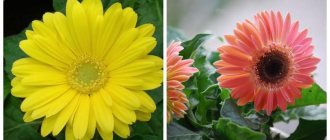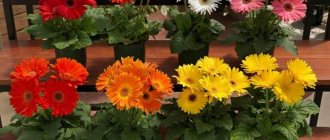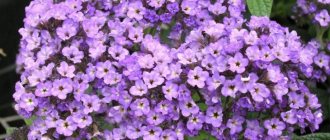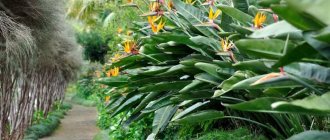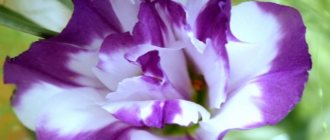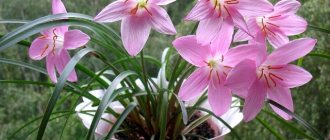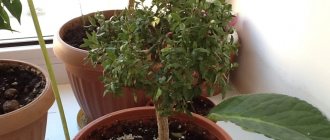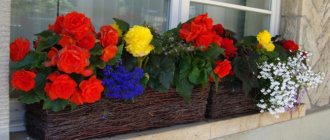Gerbera Jameson, which in English books is called the Transvaal daisy, really resembles a daisy, only large and brightly colored. The center of the flower is surrounded by satiny petals, stems rising from rich green leaves. You can find a species colored red, pink, or orange, but no one has ever seen a blue gerbera. These plants come from hot countries, so they are recommended to be planted in the sun, although they tolerate partial shade.
Flowers in a bouquet do not lose freshness for up to 14 days, and until recently the plant was grown by gardeners specifically for cutting. But now they are increasingly starting to plant it as an indoor plant. For indoor cultivation, low-growing Jameson hybrids are used, the height of which does not exceed 25 centimeters:
- Gerbera Ilios,
- Gerbera Hummingbird,
- Gerbera Happipot,
- Gerbera Parade.
A bright, beautiful gerbera will look great against any background and will decorate any room. In this article we will tell you how to plant gerbera seeds.
Reproduction methods
Often after flowering the plant begins to propagate; this can be done in several ways:
- By seeds - it is rarely used, especially if it is a garden Gerbera, since more than 10 months pass from the moment the seeds are planted until the first buds appear. But if you sow seedlings in January, then by August you can get a lush flowering plant.
- By dividing the bush - in this case, choose a four-year-old plant. This is necessary so that there are two growth points left on each bush, otherwise the bushes may die.
- Cuttings - cut off a part of the stem that should have 2 leaves and plant it in the ground. Soil temperature is at least +20 degrees. To make the rooting process faster, you need to cover it with a jar or cut plastic bottle.
Read about how to propagate Gerbera and how to care for it at home.
Plant characteristics
Gerbera (Gerbera) is a herbaceous plant from the extensive Asteraceae family. Representatives of the genus are distinguished by large flowers, similar in structure to chamomile or daisy, but much larger. Gerbera is a perennial, but in cold winter conditions or for cutting it is grown as a seasonal crop. In greenhouses, greenhouses, and in the open air, the flower is cultivated en masse all over the world.
Ornamental varieties are well suited for decorating gardens, and new, dwarf subspecies can be grown indoors. Gerbera (growing from seeds at home ensures the beginning of flowering after an average of 10 months) lives in a pot for up to 5 years, but the flowers begin to shrink from the 3rd season, so the plantings have to be rejuvenated or replaced. The structural feature of the gerbera is the presence of a short trunk growing in the soil.
Only a rosette of leaves and long, erect peduncles rise above the ground. Gerbera roots are thin and fragile, but tend to penetrate deep into the soil. The leaves are pinnately dissected, openwork along the edges. The shape of the plates is elongated, with a pointed tip. The leaf petioles are long, sometimes pubescent. Strong peduncles rise above the leafy rosette. The stems are strong, leafless, and most often covered with pubescence.
In nature, gerberas can have a height exceeding 60 cm. Indoor varieties are more compact: up to 30, and sometimes up to 20 cm.
Gerbera flowers are collected in inflorescences-baskets like daisies with large, convex centers. The marginal reed petals can be any color except blue. In the most popular varieties they are red, orange, yellow. The tubular flowers from the middle of the basket also have a variety of colors, even purple-black.
All indoor varieties are selective hybrids of Jameson's gerbera with resistant natural species. Today, about a thousand ornamental varieties with different flower sizes have been created by crossing. Gerbera inflorescences can reach from 3 to 15 cm in diameter. Reed petals along the edge of the basket are arranged in one or several rows. Semi-double and double varieties have been created, as well as varieties with different stem heights.
The most popular varieties of gerberas for rooms grow flower stalks up to 30 cm. The most popular of them are perfectly adapted for rooms and do not require special conditions. For convenience, they are divided into groups according to the shape and size of the flowers.
Small-flowered with narrow petals
A group of gerbera hybrids under the general name Race Diem. They have inflorescences of about 9 cm and a high peduncle up to 50 cm. The width of the marginal petals is no more than 2 mm.
The most popular of them are:
- Alcor - lilac or dark cherry petals;
- Aldebaran - with a rich pink color.
Small-flowered varieties are convenient for indoor growing, are unpretentious and can bloom all year round.
Large-flowered with narrow petals
Hybrids have a general name - “American”. Plants with flowers more than 10 cm in diameter and peduncles above 60 cm.
Popular varieties from this group:
- Algol – bright raspberry hybrid;
- Migar – soft pink petals;
- Jupiter or Vega - with petals ranging from yellow to orange.
The most popular of the large gerberas with medium-length petals is the bright red hybrid Mars with reed flowers along the edge, arranged in several rows.
Large-flowered with wide petals
Large plants with tall peduncles (about 60 cm) and inflorescences 13–15 cm. The color of the petals ranges from red to lemon yellow.
Popular types:
- Saturn and Marcal are variegated, orange and yellow hybrids;
- Romeo, Alamak, Delios are especially bright red varieties;
- Vera - with soft pink flowers.
Varieties Delios and Alamak can have petals of any shade of red.
Terry and semi-double
Especially decorative hybrids of gerberas, which can have both wide and narrow reed petals. The diameter of the inflorescence is from 11 to 14 cm. Peduncles can grow from 50 to 70 cm.
Popular terry gerbera hybrids:
- Sonya - scarlet;
- Kalinka – yellow;
- Spark – cherry red;
- Viola is pink.
The potted variety Durora-mix has semi-double flowers and variegated colors in all shades of red. The plants are very durable and unpretentious at home. Flower growers especially like rare hybrids with a dark color of the central disc. In Russia, the varieties Arendgost and Vincent with an almost black core are especially in demand.
Planting material
The seeds of the plant have an elongated shape with a small brush at the tip, small in size. One gram contains 300-500 pcs.
Gerbera is not a self-pollinating plant , therefore, in order to obtain seeds from a flower, it is necessary to carry out cross-pollination, artificial pollination at the time of flowering. Pollen ripens faster and is stored for 100 days.
It is worth remembering that in order to preserve the variety, both the male and female plants must be of the same species, otherwise you may end up with a plant with completely different characteristics. The result is unpredictable; the resulting seeds can produce a completely different plant in terms of characteristics.
When do they ripen and how to harvest?
After successful pollination, the seeds of the plant will be ready for collection in a month, as soon as the center of the flower becomes fluffy. The flower is disassembled by hand and the seeds are removed. It is worth remembering that the seeds retain good germination only 6 months from the moment of collection , during which time they need to be planted in the ground. The price depends on the amount of seed in the bag. For example, 25 pcs. - 80 rubles, and 10 pcs. – 0t 22 to 40.
Important : When purchasing, look at the packaging period of the seed material; if it is more than 6 months, you should not buy such seeds, their germination rate is very low.
Features of cultivation
To grow a beautiful, strong plant from a seed that will delight you with friendly flowering, you need to know the nuances of planting and subsequent care. We talked about what to avoid when growing Gerbera in pots in this material.
Sowing time
You can sow seeds at any time, starting from the moment the seed is collected . But, in order not to contradict the nature and biorhythms of the plant, it is better to plant in spring. Preparation for cultivation: soil and seeds.
Soil preparation
Gerberas love porous and light soil, which is prepared from 2 parts leaf humus, 2 parts peat and 1 part washed river sand. In this case, the soil should be neutral or slightly acidic. Before planting, the soil is disinfected by sprinkling it with a solution of potassium permanganate, the temperature of which is +50 degrees. There is no need to do anything to prepare the seeds; sowing is carried out without soaking, and they do not need any processing.
Landing rules
The flower seeds are very small, and there is no need to dig them deep into the soil ; just scatter them over the surface and sprinkle them with peat. The soil must be moist. For rapid germination, it is worth providing the planting material with certain conditions, creating a greenhouse effect.
To do this, cover the container with glass or film. The first shoots will appear in a week, but every day you need to remove the covering material for ventilation. As soon as the seeds germinate, the glass is removed.
The optimal temperature for germination is +20 degrees. Gerberas can be sown in a small container, or in separate peat pots ; this will be much preferable, since subsequent replanting into the pot will not damage the root system.
Watch a video about planting Gerbera seeds:
Choosing a pot
As soon as 3 true leaves appear on the Gerbera seedlings, it can be transplanted into a separate pot. Take a small pot - if the plant has too much space, it may not bloom.
The seedling is placed in a 700 ml clay pot. A large layer of drainage should be placed at the bottom of the pot .
Tip : Despite the fact that Gerbera will grow well in a clay container, transplanting it into a plastic pot is much preferable, since you can water the plant in a tray.
Transplantation to a permanent place
To plant gerbera seedlings, it is advisable to choose not too large pots with drainage holes, and ideally with the possibility of external watering. Place 2-3 cm of expanded clay or porous lava on the bottom, pour in the prepared substrate and use a pencil to make a recess in it corresponding to the length of the spine.
drainage-03.jpg
Then a sprout is carefully placed in this hole, which should already have 5-7 true leaves and sprinkled with earth on all sides, but so that the growth point remains visible, from above. It is advisable to water from a spray bottle with warm filtered water. The soil after replanting should always remain moist, but not swampy. The higher the ambient temperature, the more often it is necessary to wet the soil. In cold weather, this can be done only once a week.
gerbera-poliv-768×513.jpg
It is best to grow gerbera on eastern or western windowsills, and if you plan to keep it outside, then a slightly shaded, cozy place without strong winds and direct sunlight will do. The ground around the bush should be periodically loosened, providing air access to the roots, and it can be covered with some kind of mulch to prevent the growth of weeds and rapid evaporation of moisture: hay, sawdust, pieces of pine bark, last year's leaves.
This exotic chamomile will certainly reward you for your careful care with long-lasting and vibrant flowering that will delight everyone around you for several months in a row.
Caring for an indoor flower
In order for a plant to grow healthy and capable of flowering, you need to follow certain care rules:
- The plant in the active growth phase needs to be provided with a comfortable temperature - 18-24 degrees. As soon as Gerbera begins its dormant period, after the end of flowering, it is transferred to a cool place with a temperature of 14 degrees.
- When growing seedlings in winter, they need to be provided with additional lighting. If the plant does not have enough light, the seedlings will stretch out and be weak.
- As soon as the plant blooms, it is provided with 12 hours of daylight. This is due to the fact that Gerbera blooms at the end of summer, when daylight hours begin to wane. The plant is photophilous and responds very well to intense sunlight. If you want to prolong flowering in winter, provide good lighting, and the glow should be warm.
The dormant period begins when the plant stops blooming and lasts 3-4 months.- Air humidity is very important for the plant. But you cannot spray Gerbera with water - a fungal infection appears. To humidify the air, spray water around the plant, or pour pebbles into a tray and pour water into it, which should not touch the bottom of the pot.
- This is done as follows: place the pot with the plant in water for 10 minutes, then return it to the pebbles.
- Gerbera requires replanting every year into a container that will be 1-2 cm larger than the previous one. If you buy a soil mixture in a store, then select soil for planting roses (how and when to replant Gerbera after purchase?).
- 2 weeks after transplanting the seedlings, you can start feeding. For this purpose, only complex mineral fertilizers are used for flowering crops. During the growing season, fertilizing is carried out every 14 days.
- If the soil for planting is prepared correctly, then the amount of nitrogen fertilizer required for the plant is present in it. If you overfeed a Gerbera, it will begin to grow green mass and will not bloom (you can find out why indoor Gerberas do not bloom and how to care for them here).
- During the dormant period, it is important to provide the plant with comfortable conditions. Reduce watering to a minimum, lower the temperature to +14 degrees. It is necessary to water when the top layer of the earthen clod dries. No feeding is carried out at this time.
What time of year is best to propagate?
The operation is best carried out in April-May, when the flower begins active growth and young leaves appear.
Next you will see a photo of Gerbera propagation from seeds:
Watering
The plant is moisture-loving and needs abundant, timely watering during the period of active growth. But you don’t need to make a swamp in a pot either. It is advisable to water Gerbera only through a tray , since water entering the bush and shoots can cause the development of fungal diseases (read about how to recognize and treat diseases of indoor Gerbera here). It is also worth remembering that watering is carried out only with warm water. Cold liquid can cause root rot and the spread of fungus.
How to water young shoots?
The seedlings are watered moderately, but at the same time avoiding the addition of a clod of earth. Moisture should not get on the plants, so it is better to use a syringe or syringe and inject water directly into the soil. Experienced gardeners often use an old steamer for watering.
Origin of gerberas
Due to their ability to keep freshness in bouquets for a long time (up to 20 days), these flowers are often grown for cutting. In pots or outdoors, they remain decorative even longer - up to 3 months, and with proper care they can re-bloom every year. Gerberas belong to the Astrov family, being close relatives of daisies, cornflowers, chicory, marigolds, marigolds and even ordinary burdocks. But, unlike their frost-resistant relatives, they are not at all adapted to a temperate climate.
2-selekcionery.jpg
Trasvaal daisies (the second name for these plants) originate from the monsoon tropics of South Africa and nearby islands. These beautiful representatives of exotic flora prefer warmth, because the average annual temperature in their homeland is +24°C, and does not fall below +17°C. The hottest time, along with heavy rainfall, occurs in winter. In the summer, gerberas need coolness - this way they can easily endure moderate drought and gain strength for autumn flowering.


